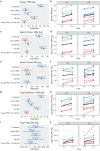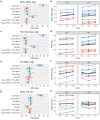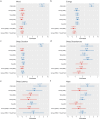Hypercaloric 16:8 time-restricted eating during 8 weeks of resistance exercise in well-trained men and women
- PMID: 40241374
- PMCID: PMC12006946
- DOI: 10.1080/15502783.2025.2492184
Hypercaloric 16:8 time-restricted eating during 8 weeks of resistance exercise in well-trained men and women
Abstract
Background: The effectiveness and practicality of time-restricted eating (TRE) when trying to maximize muscle mass and strength is unclear. Thus, we examined the effects of a hypercaloric 16:8 TRE approach during supervised progressive resistance exercise.
Methods: Seventeen healthy and well-trained men (n = 10) and women (n = 7) were randomly assigned to TRE or control (FED). Both groups consumed a 10% hypercaloric high-protein (2.2 g/kg/d) diet and performed supervised resistance exercise 4× per wk for 8 wk. TRE consumed all calories within an 8 h window starting at least 1 h post-exercise, while FED consumed the same number of calories throughout the day.
Results: Eating windows were significantly different (TRE: 7.9 ± 0.1 h vs. FED: 13.2 ± 0.6 h). Calorie, carbohydrate, fat, and protein intake did not differ statistically between groups. Total exercise volume was significantly lower in TRE than FED (6,960 ± 287 vs. 7,334 ± 289 repetitions), as were subjective daily energy ratings (week 4 = -1.41; p = 0.04, week 8 = -1.04; p = 0.06). Both groups increased maximal upper and lower body strength (1RM) and muscular endurance (ME); however, gains in squat 1RM were 4.0 ± 1.9 kg lower in TRE (p = 0.05). Both groups increased fat-free mass similarly (TRE: 2.67 kg; FED: 1.82 kg, p = 0.04), but FED added 1.4 ± 0.6 kg more fat mass (p = 0.04). Subjective mood and sleep ratings did not change in either group.
Conclusions: 16:8 TRE is viable during periods of muscle size, strength, and endurance development in well-trained young men and women when engaging in progressive resistance exercise and eating in a caloric surplus with adequate protein. However, the differences in total training volume, squat 1RM, fat mass accumulation, and energy are notable and practically relevant. These findings should be considered within the broader context of an individual's goals, lifestyle, preferences, and exercise demands.
Keywords: Skeletal muscle; autoregulatory progressive resistance exercise; body composition; chrononutrition; hypertrophy; time-restricted eating.
Conflict of interest statement
GMT is an inventor of the international patent “Compositions and methods of use of beta-hydroxy beta-methylbutyrate (HMB) associated with intermittent fasting.” Whey protein supplement was donated by Legion Athletics, Inc.
Figures






References
-
- Moro T, Tinsley G, Bianco A, et al. Effects of eight weeks of time-restricted feeding (16/8) on basal metabolism, maximal strength, body composition, inflammation, and cardiovascular risk factors in resistance-trained males. J Transl Med. 2016;14(1):290. doi: 10.1186/s12967-016-1044-0 - DOI - PMC - PubMed
Publication types
MeSH terms
LinkOut - more resources
Full Text Sources
